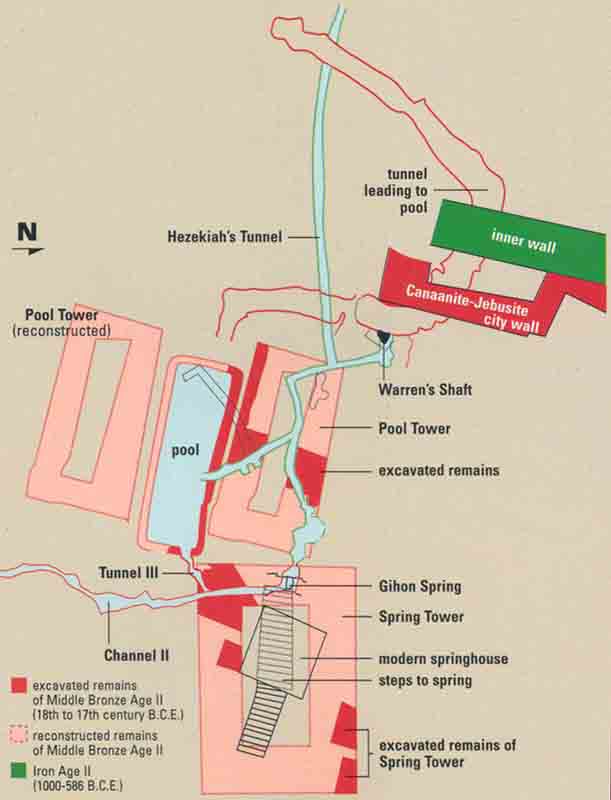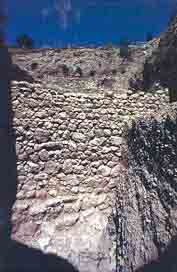
To say that you should throw out all your books on the archaeology of Jerusalem would be going too far, especially since I wrote two of them.1 But it is true that books on the archaeology of Jerusalem, including my own, now contain a lot of misinformation. More bluntly, they are wrong. The lesson: The archaeological story is never finished.
You have been told that King Hezekiah built a 1,750-foot tunnel under Jerusalem in the late eighth century B.C. to bring water into the city from the Gihon Spring, the city’s only natural water source, which was located outside the city wall.a Wrong! The Gihon Spring was inside the wall. And water was already available inside the city. The one thing everyone agreed on turns out to be wrong. So why did Hezekiah build his famous tunnel?

You have been told that the tunnel was necessary to provide safe access to the Gihon Spring, which is located in a vulnerable position, low on the eastern slope of the city. A city wall, you were told, could not be built far enough down the slope to protect the spring, lest it be commanded by volleys from the other side of the Kidron Valley.2 Wrong! A city wall has now been found that did enclose the Gihon Spring.


You were offered a variety of explanations as to how the two teams of tunnelers who dug Hezekiah’s Tunnel from opposite ends managed to meet in the middle, as described in an inscription found in the tunnel. According to the latest and most widely accepted theory, the tunnelers were simply following a narrow, natural, karstic crack through which water seeped.3 All the explanations, including this one, are wrong. We still don’t know the answer to this puzzle.
You were told that water could be drawn up through Warren’s Shaft, a 52-foot subterranean shaft, the bottom of which was fed by a tunnel leading from the Gihon Spring. Wrong! Warren’s Shaft was never used to draw water, as detailed in the following article in this issue.
You were told that a channel-tunnel (part above ground and part underground) leading south from the spring along the eastern side of the city irrigated the adjacent fields in the Kidron Valley. This channel-tunnel, which is known as the Siloam Channel (not to be confused with the Siloam Tunnel, as Hezekiah’s Tunnel is sometimes called in the older literature), had windows to let out the water. You were told that it was probably built by King Solomon.4 Wrong on both counts! The channel was built more than 700 years before King Solomon arrived on the scene, and it could not have been used this way to irrigate the fields.


You were told by the great British archaeologist Kathleen Kenyon that there was nothing more to be gained from further digging in what is now referred to as the City of David, the rocky 12-acre site south of the Temple Mount where the original city of Jerusalem was located. Two excavations have now proved her wrong on this point and have disputed many of her findings. The first was the eight-year excavation directed by the late Israeli archaeologist Yigal Shiloh, several of whose conclusions are now being questioned in turn; and the second is the continuing excavation directed by Ronny Reich and Eli Shukron of the Israel Antiquities Authority.

The books are going to have to be rewritten as a result of Reich and Shukron’s work. And they’re still digging. They are not even close to solving all the problems. They never will be. But they are proof that there is still more to be learned from digging. Reich and Shukron have already written one ground-breaking article (if you will excuse the pun) in BAR on their discovery of two imposing Middle Bronze Age (c. 18th-century B.C.) towers (the Spring Tower and the Pool Tower) that protected the Gihon Spring and an adjacent pool of water.5 And every time I go to Jerusalem, they dazzle me with exciting new developments.

Their latest find is a major late-eighth-century B.C. city wall that ran close to the floor of the Kidron Valley and enclosed the Gihon Spring. It has survived in places to a height of more than 16 feet. It could only have been connected to the two Middle Bronze Age towers. An earlier eighth-century B.C. wall, uncovered by both Kenyon and Shiloh, stood higher on the hill. The new wall—which has never before been exposed—was doubtless built to enclose the growing city as it expanded down the slope. Houses covered the area between the two walls. It should not be surprising that two walls surrounded this part of Jerusalem in the eighth century B.C. Archaeologists at Lachish have found the same phenomenon of two walls surrounding the city in the same period.6
The newly discovered wall was low enough on the slope to enclose the Siloam Channel. According to Reich and Shukron, this channel (also called Channel II), like the newly discovered towers adjacent to the Gihon Spring, was built in the Middle Bronze II period (c. 1800–1550 B.C.)—and not in the tenth century B.C. by Solomon, as Shiloh had suggested. Reich and Shukron know this because the Spring Tower, dated by pottery to the Middle Bronze Age, is built over the beginning of the channel and thus was built after the channel.



Moreover, Reich and Shukron discovered that the Siloam Channel was dug as a channel for the first 600 feet, not as an underground tunnel, as Shiloh had claimed. Huge boulders were then levered over the top of the channel; it would have been next to impossible to lift out the boulders wedged into the top of the channel, so the channel was well protected.
Shiloh supposed there were windows in the channel to irrigate the adjacent fields in the Kidron Valley. Reich and Shukron found no windows, however, so the water in the channel could not have been directed to the adjacent fields in this way. Further, from at least the eighth century B.C. onward, the channel was within the city wall.7
Now we know that this channel carried water to a pool in the southern part of the city, a second water supply inside the city. Again we must ask: Why did Hezekiah take such pains to build his famous tunnel, which seems to have done the same thing as the channel, although the tunnel’s outlet was on the western, rather than the eastern, side of the city? Reich and Shukron say they don’t know—at least not yet. As usual, when some problems are solved, new ones arise. And they have risen aplenty.
My own suggestion is that Hezekiah, under the threat of attack by the Assyrian king Sennacherib, may have recognized that the tunnel afforded greater protection of the city’s water supply than the pool at the Gihon Spring and the channel. True, the pool was protected by at least two towers (and perhaps three). Yet these prominent towers would have called a potential enemy’s attention to the importance of this area. Moreover, a city gate—the most vulnerable point in a city’s fortifications—was usually the point of attack. By digging the tunnel, Hezekiah redirected the water from the Gihon Spring to the other (western) side of the city, siphoning the water off before it reached the tower-protected pool. Even if an enemy such as Sennacherib breached the lower wall and captured the pool, the city’s water supply would still be safe—at least until Sennacherib found the source (which was probably well camouflaged) and was able to stop it up.


This scenario is especially attractive if we accept the two-assault theory of Sennacherib’s attack, the first in 701 B.C. and the second in 688 B.C., a theory accepted by such leading scholars as William Foxwell Albright and John Bright and argued for in the article in this issue by William H. Shea. According to this theory, King Hezekiah of Judah averted the destruction of Jerusalem in 701 B.C. by agreeing to pay tribute to Assyria. Hezekiah then had several years to strengthen the city’s defenses in case the Assyrians returned. In this period, he built additional walls—probably the recently discovered late-eighth-century wall and the 23-foot-wide Broad Wall, still visible in the Old City of Jerusalem,8 and he better secured the city’s water supply by digging his ambitious tunnel under the city.
Reich and Shukron also dispute a recent claim made by Israeli geologist Dan Gill, who sought to explain in these pages how the two teams of tunnelers digging Hezekiah’s Tunnel from opposite ends managed to meet: According to Gill, the tunnelers followed a narrow, naturally formed karstic channel.9 If this were so, Reich and Shukron ask me, why are there so many twists and turns on either side of the meeting point, apparently created by the tunnelers as they sought to find each other? And, if the tunnelers were simply following a natural karstic channel, why are there three “false” tunnels near the meeting point that stop after a few feet, indicating that the tunnelers did not know in which direction to dig? Good questions.
The water system of ancient Jerusalem is still not completely understood. And, unfortunately, the picture is becoming increasingly complicated. But it is fascinating to watch as more and more of the pieces of the puzzle come to light.
MLA Citation
Footnotes
Endnotes
Hershel Shanks, The City of David: A Guide to Biblical Jerusalem (Jerusalem: Bazak, 1973), Jerusalem: An Archaeological Biography (New York: Random House, 1995).
See Kathleen M. Kenyon, The Bible and Recent Archaeology, rev. ed. by P.R.S. Moorey (Atlanta, GA: John Knox, 1987), p. 91.
Karst is a geological term that describes an irregular region of sinks, caverns and channels created by groundwater seeping and flowing through underground rock formations. See Dan Gill, “How They Met,” BAR 20:04 (available on our Web site: www.bib-arch.org).
See Hershel Shanks, “The City of David After Five Years of Digging,” BAR 11:06.
See Ronny Reich and Eli Shukron, “Light at the End of the Tunnel,” BAR 25:01 (also available on our web site: www.bib-arch.org).
Although the Siloam Channel carried water to the southern part of the city (and the royal gardens), the water could also be siphoned off by a separate short tunnel (called Tunnel III in Louis-Hugues Vincent’s numbering) that connected the Siloam Channel to the pool adjacent to the Gihon Spring. That pool was protected by the so-called Pool Tower that Reich and Shukron have discovered and, presumably, by another similar tower on the other side of the pool. Incidentally, Vincent designated Hezekiah’s Tunnel as Channel I and the Siloam Channel as II.
See Nitza Rosovsky, “A Thousand Years of History in Jerusalem’s Jewish Quarter,” BAR 18:03.
See Dan Gill, “How They Met,” BAR 20:04.

